You can live comfortably in Indonesia on about $600–$1,000 a month depending on city and taste, with smaller towns often costing $300–$400. Rent for a one‑bedroom ranges from $200–$1,000, food averages near $207, and utilities add $100–$200. Public transport and scooters keep commuting cheap, while private cars raise costs. Healthcare and international schooling add up if you choose private options, and the rest of this guide breaks those details down.
Average Monthly Living Costs in Indonesia
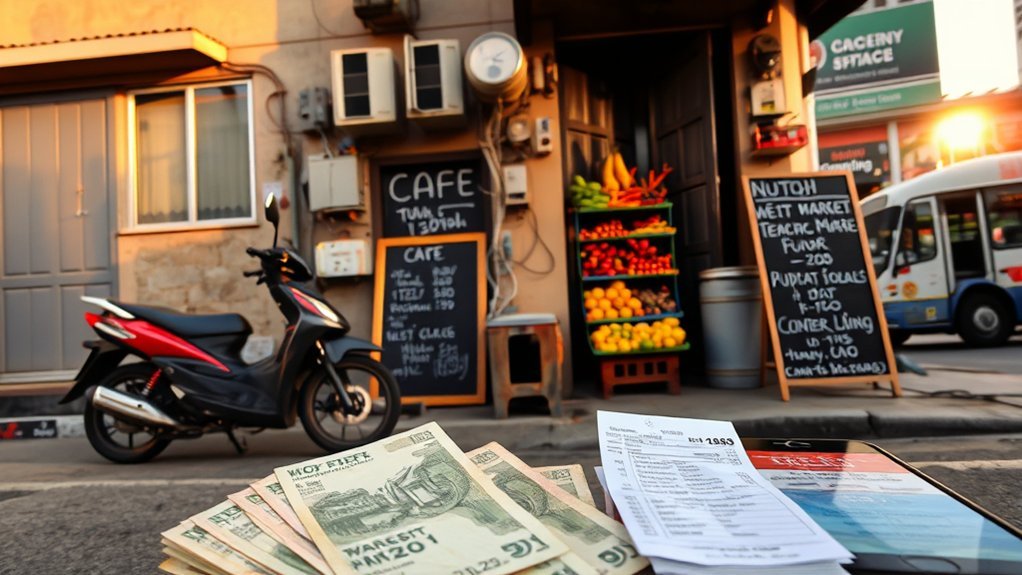
On average, you’ll spend roughly $600–$1,000 a month living in Indonesia, though your location and lifestyle will shift that range considerably.
You’ll see the biggest variance in rent: a one-bedroom apartment in a city center runs about $400–$1,000, while outskirts can drop to $200.
Factor in food expenses of roughly $207 monthly if you mix local eateries and groceries; meals at street stalls often cost $1–$3, while tourist spots hit $10–$15.
Transportation costs are low — around $43 a month — thanks to cheap public transport fares near $0.30 per ride and affordable motorbike options.
Utility costs (electricity, water, internet) typically add $100–$200 depending on air-conditioning use.
If you prioritize budgeting, choose suburban housing, cook locally, and rely on public transport.
If you value convenience and healthcare access, expect higher rent and private care, though public healthcare remains a low-cost safety net.
Visas, Immigration and Legal Requirements
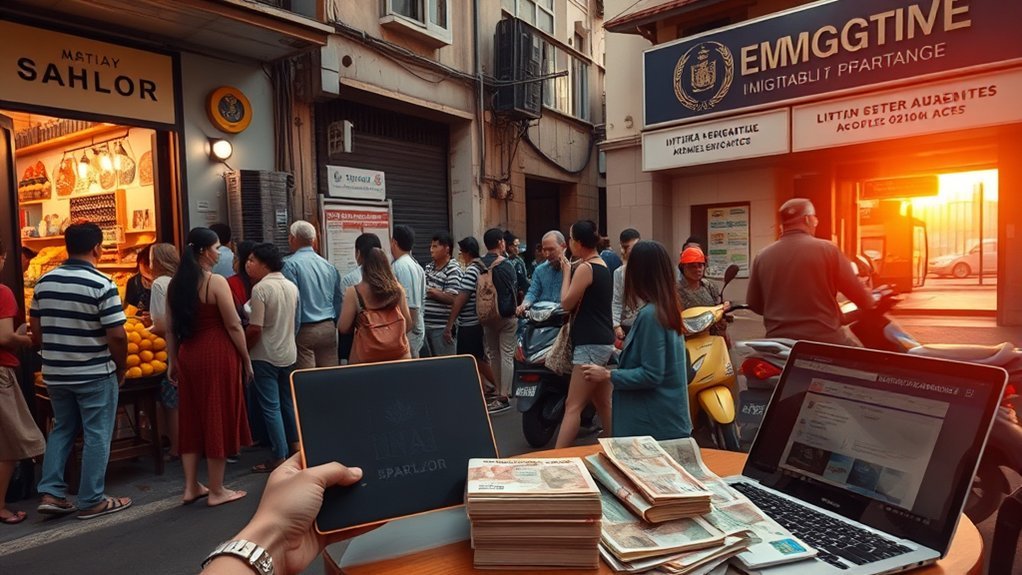
Maneuvering through Indonesia’s visa and immigration rules is essential if you plan to stay beyond a short holiday, since options, costs, and eligibility vary widely depending on your purpose and length of stay.
You’ll typically enter on a tourist visa—valid up to 60 days and costing around $50—which suits short visits but not work or long-term residence.
For extended stays you’ll look at a KITAS (limited stay permit), commonly costing several hundred dollars and requiring sponsor documentation or employer support.
Social-cultural visa options exist if you’re visiting family or engaging in cultural activities and can offer more flexibility than a tourist visa.
If visiting family or taking part in cultural activities, a social‑cultural visa often provides more flexibility than a tourist visa.
If you’re over 55 and meet financial plus health insurance thresholds, a retirement visa gives longer-term stability but has strict eligibility and renewal rules.
Stay proactive: immigration rules and legal requirements change often, so check official sources or consult an immigration agent to avoid surprises and guarantee your paperwork, renewals, and work permissions match your plan.
Housing and Rental Market by City
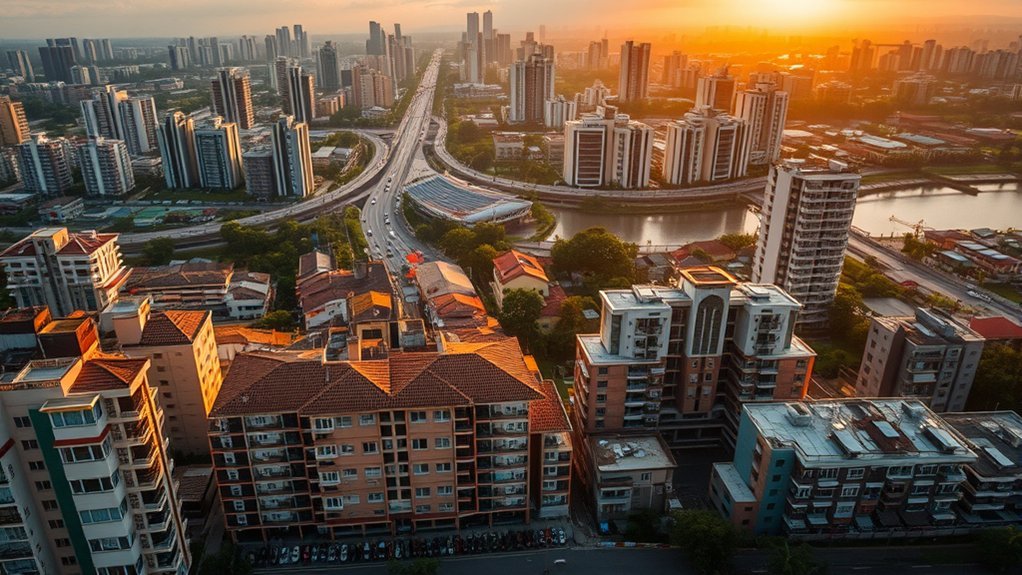
When you look for housing, city-center rents in places like Jakarta or Ubud will be noticeably higher than in suburbs or outskirts.
Expect one-bedrooms from about $400–$1,000 in major cities versus $200–$400 on the outskirts, with islands like Bali showing wide variation (Canggu ~$300, Ubud ~$660).
Don’t forget utilities—plan an extra $100–$200 monthly when comparing total costs.
City Center Rents
Across Indonesian city centers you’ll find rents that vary sharply by location, so you’ll want to pick based on budget and lifestyle.
City center rents for a one-bedroom apartment span roughly $300–$1,000 monthly, with clear differences by city. Jakarta leans toward the lower end (~$400), Canggu about $300, and Ubud can reach $660.
If you need more space, expect three-bedrooms up to $1,000 in Canggu and $2,240 in Ubud.
Compare options practically:
- Jakarta: one-bedroom ~ $400 — good for budget urban living.
- Canggu: one-bedroom ~ $300 — cheaper, popular with digital nomads.
- Ubud: one-bedroom up to $660 — pricier, quieter lifestyle.
- Larger units: three-bedrooms vary widely, plan accordingly.
Suburb and Outskirts
If you head to the suburbs and outskirts of major Indonesian cities, you’ll usually find one-bedroom rentals for about $200–$400 per month, making them a much cheaper option than city centers.
You’ll see suburban areas like Semarang and Yogyakarta offering affordable housing with larger living spaces, so families or remote workers get more room for less.
Rental prices here stay competitive, and utility costs—electricity, water, internet—typically add $100–$200 monthly, which you should factor into living expenses.
Public transport is widely available, letting you commute without owning a car.
Compared to city-center rents, suburbs give better value: lower monthly outlays, more space, and decent access to amenities, making them a practical choice if you prioritize cost and comfort.
Transportation: Public Transport and Private Vehicles
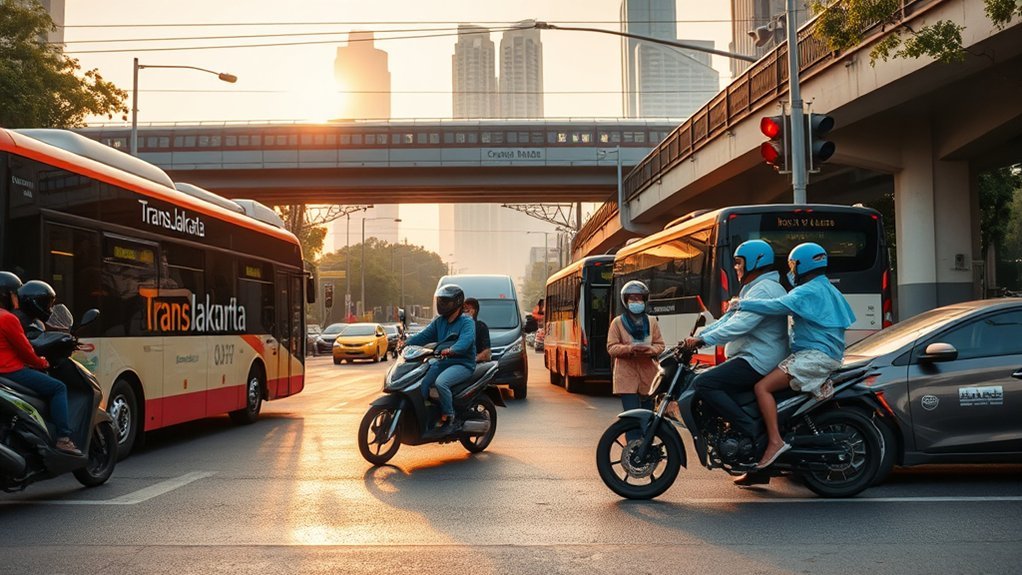
You’ll find public transport in Indonesia is very cheap — buses and trains cost about $0.30 per ride and monthly passes in cities like Jakarta run around $14.50, making them the most budget-friendly option for daily commuting.
Ride-hailing services (Gojek, Grab) charge roughly $0.50 per km and scooters can be rented for $50–$100 monthly, offering flexibility if schedules or transfers don’t suit you.
If you’re considering buying a car or motorcycle, factor in insurance, maintenance, parking and fuel, which can quickly outweigh the low per-ride costs of public transit.
Public Transport Options
While Jakarta and other Indonesian cities offer a range of ways to get around, you’ll typically choose between low-cost public transit—buses (~$0.30 per trip), commuter trains (fares vary by distance and service), and monthly passes (~$14.50)—or private options like scooters and ride-hailing (about $0.50/km), each with trade-offs in speed, comfort, and cost.
You’ll find public transportation highly affordable for daily use, while ride-hailing services give convenience and door-to-door trips. Consider scooters for short, traffic-beating rides; they’re cheap to rent and easy to park.
Compare these points when planning a budget.
- Cost: buses vs trains vs monthly public transport passes
- Convenience: ride-hailing services vs scheduled transit
- Speed: scooters often fastest in urban traffic
- Budget impact: affordability vs hidden vehicle expenses
Owning Private Vehicles
Owning a private vehicle in Indonesia changes your budget and routine more than you might expect: beyond the purchase price you’ll pay for insurance, maintenance, parking and fuel (gas runs about $0.75 per quarter gallon).
So compare those recurring costs to cheaper alternatives like $0.30 bus rides, $0.50/km ride-hailing, or $50–$100/month scooter rentals before deciding.
If you drive, factor regular maintenance and parking fees into monthly totals; traffic can raise fuel use, so gas prices hit your wallet faster than mileage estimates suggest.
For many, scooters meet daily needs at average rental prices that beat ownership.
Public transport and ride-hailing remain budget-friendly alternatives for occasional trips, while taxis or owning private vehicles fit those needing flexibility or cargo capacity.
Food and Grocery Expenses

Because food costs are much lower in Indonesia, you’ll find everyday meals and groceries stretch your budget further than in the U.S.; the average monthly food bill is about $207 versus $568 in America.
You’ll quickly notice food and grocery expenses are affordable compared: a lunch runs about $1.87 vs. $16.60 in the USA. Local warungs and street food make eating out cheap, while mid-range and Western restaurants raise your bill.
- Eat local: meals at local warungs or street food stalls cost $1–$2, ideal for daily dining.
- Mid-range options: expect $5–$15 per meal if you want more comfort or variety.
- Groceries: staple items like rice, chicken, and eggs are considerably cheaper than in the U.S., so cooking at home saves more.
- Budget tip: mix street food with home-cooked staples to keep the average monthly food expense low.
You’ll manage a comfortable food budget by prioritizing local options and basic staples.
Healthcare and Health Insurance Options

Healthcare in Indonesia mixes an affordable public system with private options that many expats prefer, but you should expect trade-offs: public clinics under JKN are cheap or free yet often crowded and under-resourced, while private hospitals like BIMC (Bali) and Siloam offer higher-quality, English-speaking care at out-of-pocket prices—routine private visits typically run $10–$30, and serious procedures may mean flying to Singapore or Australia. You’ll find the healthcare system in Indonesia offers extensive access but variable quality of care; JKN covers ~82% nationally but may not meet expat expectations. Private healthcare facilities deliver faster service and better amenities, yet that raises medical costs and can make living here feel expensive to live for those relying on private care. Get thorough health insurance that covers local treatment, specialist fees, and medical evacuation. Compare plans for network hospitals, exclusions, and emergency riders to avoid surprise bills and secure consistent quality of care.
| Option | Typical cost |
|---|---|
| JKN public | Very low/Free |
| Private visit | $10–$30 |
| Evacuation/abroad | Variable |
Education and Schooling Costs for Expats

After sorting out health coverage, you’ll want to evaluate schooling options—education costs can reshape your budget as much as medical bills.
You’ll find public schools are free for expatriate children but often overcrowded and under-resourced, so they’re a budget-friendly yet imperfect choice. International schools, preferred by many for higher standards, charge tuition fees from $4,000–$14,000 per year. Private schools fill the middle ground with fees typically $30–$400 annually, varying widely by quality.
- Consider public schools: no tuition fees but limited facilities and crowded classrooms.
- Compare international schools: higher tuition fees, consistent curricula, and familiar environments for expat kids.
- Evaluate private schools: affordable options that can offer decent standards depending on the institution.
- Factor long-term costs: university tuition averages about $4,500/year, and the growing expat community in Yogyakarta and Bali is expanding international options.
You’ll balance cost, curriculum, and location to match your family’s priorities.
Entertainment, Sports and Lifestyle Expenses

Many everyday leisure options in Indonesia cost far less than you’d pay back home, so you can stay active and entertained without breaking the bank. You’ll find entertainment like movies for $3–$5 and gym membership plans around $20–$30/month, so routine fitness is affordable. Outdoor activities such as surfing and hiking are low-cost or free, while wellness activities—from $5 yoga classes to $100 spa days—let you choose based on budget. Routine doctor visits at $10–$30 show the healthcare system remains cheaper than in many Western countries, which lowers overall living costs and gives you more flexibility for leisure.
| Category | Typical Price | Notes |
|---|---|---|
| Movies (entertainment) | $3–$5 | Cheap nights out |
| Gym membership | $20–$30/mo | Standard facilities |
| Outdoor activities | Low / Free | Surfing, hiking spots |
| Wellness activities | $5–$100 | Yoga to spas |
| Doctor visit (healthcare system) | $10–$30 | Affordable routine care |
Taxes, Banking and Cost-saving Tips
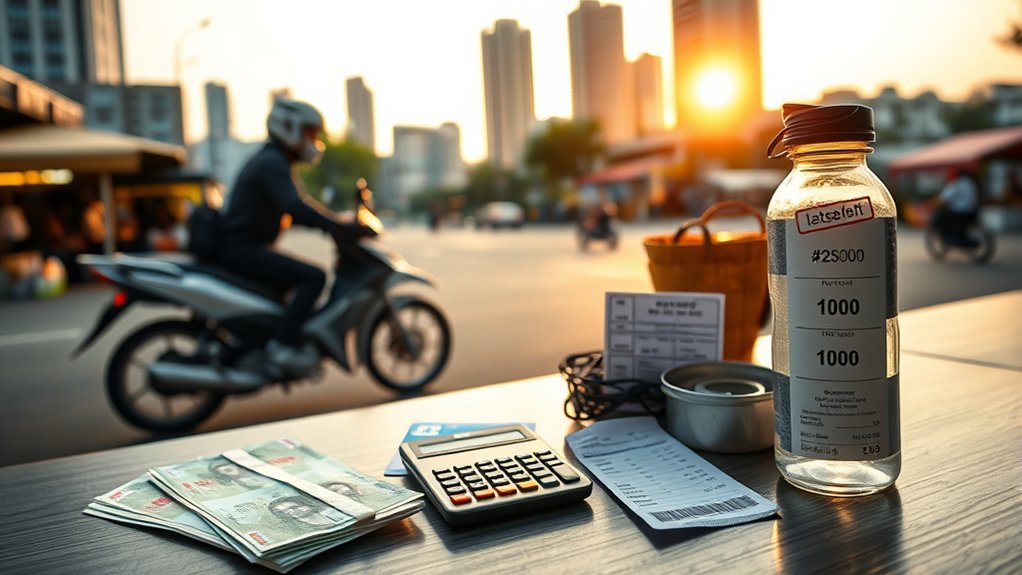
While taxes, banking and daily money habits might feel overwhelming at first, getting them right will save you time and cash. Indonesia’s progressive taxes mean you’ll pay tax on local income; foreign residents earning under IDR 4.8 billion face a top rate around 30%, so budget accordingly.
Open a local bank account to simplify payments, reduce currency exchange fees and manage living costs in IDR. Online banking lets you avoid queues and transfer funds quickly for bills and rent.
- Learn tax obligations early — file correctly to avoid penalties and unexpected costs.
- Use local banking and e-wallets — lower fees, faster payments, easier bill management.
- Shop at local markets for groceries — food costs drop considerably versus supermarkets.
- Favor public transport — it cuts daily commuting expenses compared with private taxis.
Expatriates who combine smart banking, tax awareness and local-market shopping will see meaningful savings and smoother finances.
Frequently Asked Questions
Can US Citizens Move to Indonesia?
Yes — you can move to Indonesia: explore visa options like KITAS or retirement visas, weigh cost of living, healthcare access, local employment rules, join expat communities for cultural integration, and compare practical steps before committing.
Is 1000 Dollars a Lot in Indonesia?
Yes — $1,000 goes far in Indonesia compared to Western costs; cost comparison shows it covers local standards comfortably. You’ll need lifestyle changes, budgeting tips, awareness of currency exchange, and expatriate experiences to optimize spending.
How Much Does a House Cost in Indonesia in US Dollars?
You’ll pay anywhere from about $1,000 per sqm in city centers to $200–$1,000 monthly for rental options; house prices vary widely, so compare neighborhood comparison, housing market trends, property taxes, living conditions practically.
Is It Cheap for an American to Live in Indonesia?
Yes — you’ll find the cost of living much lower: expat lifestyle costs, food expenses, transportation costs, housing options, and entertainment expenses are all cheaper, so you’ll stretch a US budget far further while enjoying local conveniences.
Conclusion
Living in Indonesia is often cheaper than in Western countries, yet costs vary—Jakarta and Bali run higher than smaller cities. You’ll save on food and transport but pay more for international schooling and private healthcare. Factor visa fees, taxes and insurance into your budget. Compare neighborhoods, use local markets, and consider motorbikes over cars to cut costs. Like a traveler with a pocket atlas, you’ll find value and choices if you plan wisely.


